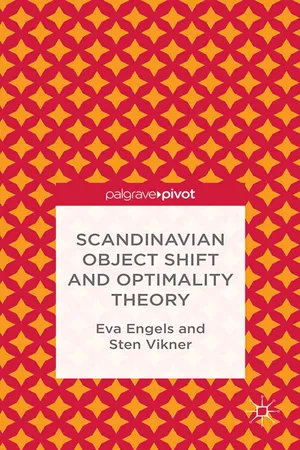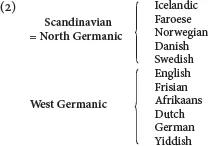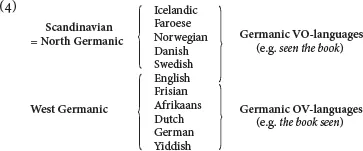
- English
- ePUB (mobile friendly)
- Available on iOS & Android
eBook - ePub
About this book
This book presents an account of object shift, a word order phenomenon found in most of the Scandinavian languages where an object occurs unexpectedly to the left and not to the right of a sentential adverbial. With new and original observations, it is an important addition to the fields of phonology, optimality theory and theoretical syntax.
Frequently asked questions
Yes, you can cancel anytime from the Subscription tab in your account settings on the Perlego website. Your subscription will stay active until the end of your current billing period. Learn how to cancel your subscription.
At the moment all of our mobile-responsive ePub books are available to download via the app. Most of our PDFs are also available to download and we're working on making the final remaining ones downloadable now. Learn more here.
Perlego offers two plans: Essential and Complete
- Essential is ideal for learners and professionals who enjoy exploring a wide range of subjects. Access the Essential Library with 800,000+ trusted titles and best-sellers across business, personal growth, and the humanities. Includes unlimited reading time and Standard Read Aloud voice.
- Complete: Perfect for advanced learners and researchers needing full, unrestricted access. Unlock 1.4M+ books across hundreds of subjects, including academic and specialized titles. The Complete Plan also includes advanced features like Premium Read Aloud and Research Assistant.
We are an online textbook subscription service, where you can get access to an entire online library for less than the price of a single book per month. With over 1 million books across 1000+ topics, we’ve got you covered! Learn more here.
Look out for the read-aloud symbol on your next book to see if you can listen to it. The read-aloud tool reads text aloud for you, highlighting the text as it is being read. You can pause it, speed it up and slow it down. Learn more here.
Yes! You can use the Perlego app on both iOS or Android devices to read anytime, anywhere — even offline. Perfect for commutes or when you’re on the go.
Please note we cannot support devices running on iOS 13 and Android 7 or earlier. Learn more about using the app.
Please note we cannot support devices running on iOS 13 and Android 7 or earlier. Learn more about using the app.
Yes, you can access Scandinavian Object Shift and Optimality Theory by E. Engels,S. Vikner in PDF and/or ePUB format, as well as other popular books in Languages & Linguistics & German Language. We have over one million books available in our catalogue for you to explore.
Information
Part I
Object Shift
1
Introduction
Abstract: This brief chapter introduces the phenomenon of object shift, sets out the plan of the book, and discusses different subdivisions within the Germanic languages.
Engels, Eva and Vikner, Sten. Scandinavian Object Shift and Optimality Theory. Basingstoke: Palgrave Macmillan, 2014. DOI: 10.1057/9781137431646.0008.
This book is about object shift, which is a clause-internal leftwards movement that is assumed to have taken place when an object occurs to the left of a clause-medial adverbial, i.e. relatively high (or relatively far left) in the clause, (1a) instead of occurring in the expected VP-internal position, i.e. relatively low (or relatively far right) in the clause, (1b).

Object shift is found in a subgroup of the Germanic languages, the Scandinavian languages. In Chapter 4, object shift will be compared to scrambling, which is a related movement of objects (among other things) that is also clause-internal, and which is found in a different subgroup of the Germanic languages, the Continental West Germanic languages. There is only one Germanic language which has neither object shift nor scrambling, and that is the most widely spoken language of the Germanic group, English.
Part I of the book (Chapters 1–5) discusses object shift in general.
This brief introductory chapter, Chapter 1, discusses different subdivisions within the Germanic languages, before object shift is properly introduced in Chapter 2, which outlines the variation in object shift found across the Scandinavian languages.
Chapter 3 presents the basic assumptions of Optimality Theory and reviews some previous optimality-theoretical analyses of object shift.
Chapter 4 sets out our Optimality Theory approach to object shift, which builds on three main ideas:



This chapter also shows how the main differences between object shift and scrambling can be accounted for by assuming different rankings of two particular constraints.
Finally, Chapter 5 summarises the findings of Part I.
Part II of the book (Chapters 6–9) focuses on the interaction between object shift and another syntactic movement, VP-topicalisation, that is, the movement of the verb phrase to the clause-initial position. We often refer to remnant VP-topicalisation, which is the same movement, except that one or more constituents have moved out of the VP before the VP is moved to the clause-initial position. The case that is particularly relevant here is the type of remnant VP-topicalisation that results from object shift applying before the VP is moved to the clause-initial position.
After an introduction in Chapter 6, Chapter 7 argues in favour of a remnant VP-topicalisation approach to occurrences of non-finite verbs in clause-initial position, rejecting a V°-topicalisation analysis.
Chapter 8 shows how object shift in remnant VP-topicalisation constructions can be accounted for in the optimality-theoretical analysis of object shift set out in Part I and discusses various asymmetries related to object shift during remnant topicalisation.
Chapter 9 summarises the results.
The following page shows two maps of where the Germanic languages are spoken today (while admittedly completely ignoring the many places where English is spoken outside the British Isles). The first map is of northern Europe, and the second one is of the southernmost part of Africa.
It is customary to divide the Germanic languages spoken today into two groups. This can either be done on a genetic (i.e. historical) basis or on a typological one, and the only difference concerns the status of English.
When divided along genetic lines, the Germanic languages consist of the Scandinavian (i.e. North Germanic) group and the West Germanic group, where all the languages in a group can be traced back to one and the same ancestor language (Old Norse for Scandinavian and Proto-West-Germanic for West Germanic):


FIGURE 1.1 The Germanic languages
Typological divisions focus on a particular feature or set of features, even if that means disregarding the historical relationship between languages. One very common typological division of the Germanic languages is the one between VO-languages (e.g. English, VO = verb-object order) and the OV-languages (e.g. German, OV = object-verb order). This difference is observable in the position of the object relative to the non-finite verb:

When the Germanic languages are divided typologically into VO-languages vs OV-languages, the result is the following two groups, as English is now grouped with the Scandinavian languages rather than with its West Germanic relatives:

The Germanic OV-languages are sometimes referred to as the Continental West Germanic languages as English is not spoken in continental Europe (even though this term ignores the fact that Afrikaans is actually not spoken in continental Europe either).
The Scandinavian languages are all descendants of Old Norse, in fact they were all mutually intelligible dialects of this language until around 1200. Within the present day Scandinavian languages, a typological distinction is often drawn between Mainland Scandinavian and Island Scandinavian:

What charact...
Table of contents
- Cover
- Title
- Part I Object Shift
- Part II Object Shift in Remnant VP-Topicalisation Constructions
- Appendices
- References
- Index